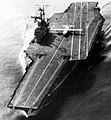File:Lockheed KC-130F Hercules aboard USS Forrestal (CVA-59) on 30 October 1963.jpg
Appearance
Lockheed_KC-130F_Hercules_aboard_USS_Forrestal_(CVA-59)_on_30_October_1963.jpg (458 × 495 pixels, file size: 67 KB, MIME type: image/jpeg)
File history
Click on a date/time to view the file as it appeared at that time.
| Date/Time | Thumbnail | Dimensions | User | Comment | |
|---|---|---|---|---|---|
| current | 16:05, 21 February 2010 |  | 458 × 495 (67 KB) | Kyteto | Cropped image to even the image out a bit |
| 18:39, 7 October 2006 |  | 458 × 550 (40 KB) | Catsmeat | {{PD-USGov-Military-Navy}} USS Forrestal: CVA-59, with a C-130 on the deck. CV-59 Forrestal Category:C-130 Hercules |
File usage
The following 3 pages use this file:
Global file usage
The following other wikis use this file:
- Usage on da.wikipedia.org
- Usage on de.wikipedia.org
- Usage on el.wikipedia.org
- Usage on fr.wikipedia.org
- Usage on hu.wikipedia.org
- Usage on it.wikipedia.org
- Usage on ja.wikipedia.org
- Usage on ko.wikipedia.org
- Usage on ms.wikipedia.org
- Usage on nl.wikipedia.org
- Usage on pnb.wikipedia.org
- Usage on pt.wikipedia.org
- Usage on uk.wikipedia.org
- Usage on vi.wikipedia.org
- Usage on zh.wikipedia.org


